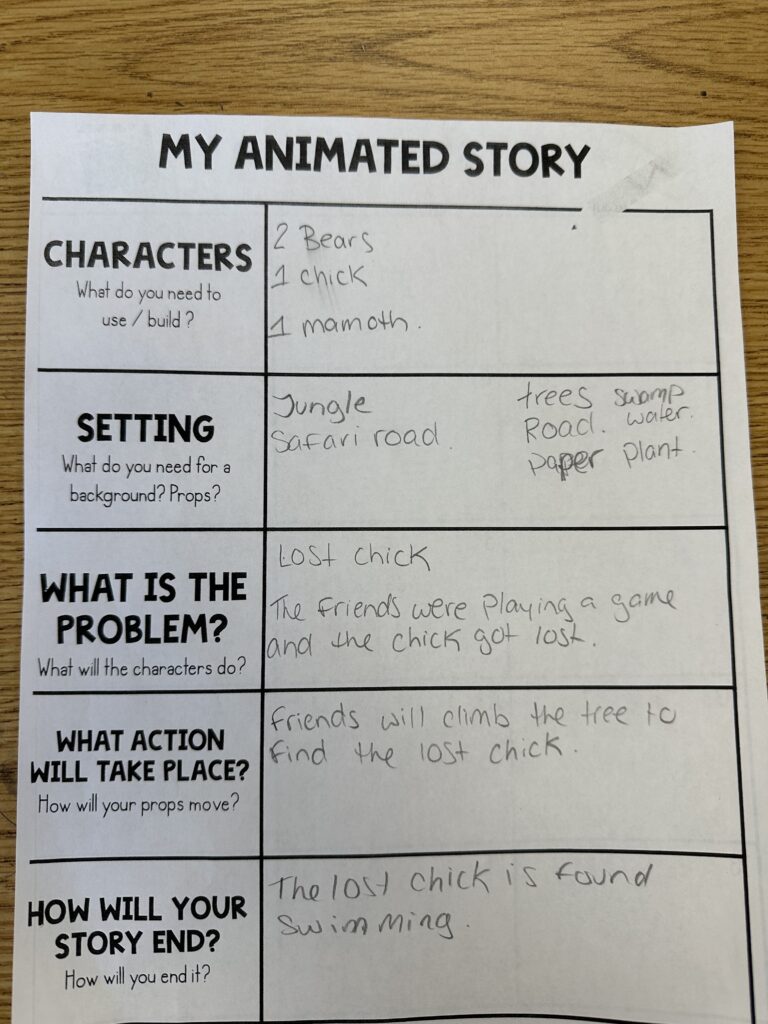DESCRIPTION: WHAT HAPPENED?
This week for our Technology class we visited an elementary school in the area and created stop motion movies with a third-grade class. We were sorted into groups of teacher candidates and students. In my group there were three teacher candidates including myself and four grade three students. The students chose to use their desk pets as the main characters in the stop motion movie. The students guided the ideas of the movie and myself, and my teacher candidate classmates helped facilitate their ideas, filmed and directed the production
FEELINGS:
I was excited for this experience because I wanted to get into a real classroom and spend some time with the kids. I was also happy that I would be in a group with some of my own classmates so that it would be easier to work with the children and keep them on task. As we began making our movie, I thought it was fun to listen to the kid’s ideas and talk to the kids and get to know them. At times I was worried that some of the kids were nor participating the same as others, so I was trying to encourage participation from everyone.
EVALUATION: THE GOOD & BAD
Overall, the activity went very well and had many positive aspects. The students were full of creative ideas and seemed to really enjoy the process of making their stop-motion movie. The time passed quickly because everyone was mostly engaged and having fun, and using the stop-motion app itself was easy and intuitive for both the students and us as teacher candidates. However, there were also some challenges. At times, one or two students needed extra encouragement to participate, and the limited space made it difficult for everyone to be involved at the same time. Our group had to work in a small area, which meant some students had to wait their turn to contribute. In addition, the short time frame limited what we could do with props, so we had to rely on materials already in the classroom or things that could be created quickly. Despite these challenges, the experience was enjoyable and valuable for both the students and us.
ANALYSIS:
Reflecting on this experience, I realized how important it is to create learning environments that balance creativity with structure. The students’ excitement and creative ideas showed how engaging technology based activities can be when students are given ownership of the process. However, there were challenges such as limited space, time, and uneven participation at times. These challenges highlighted the need for clear planning and classroom management skills. I learned that setting clear roles or rotating responsibilities could help ensure that every student remains actively involved, even in small groups. This experience also reminded me that flexibility and quick problem-solving are essential skills for teachers, especially when working with limited resources. In the end, it reinforced the idea that meaningful learning can happen when students are having fun and collaborating, even if the process feels a little messy at times.
CONCLUSION:
If I were to do this activity again, I would plan ways to keep all students more consistently engaged throughout the process. For example, I could assign specific roles such as director, photographer, prop manager, or storyteller so that each student has a clear responsibility at every stage. This would help prevent anyone from feeling left out while also keeping the group organized. I would also try to find a larger workspace to make it easier for everyone to participate. Additionally, bringing a few extra materials or creating backgrounds or props in advance could help the students be more creative without taking extra time during filming
ACTION PLAN:
If a similar situation arose again, I would begin by organizing the group to ensure equal participation. Before starting the activity, I would assign or let students choose specific roles, such as director, photographer, or prop organizer, so that everyone has a clear and active part to play. I would also try to find extra space ahead of time by booking additional rooms if possible, so everyone had lots of space to spread out.
To save time, I’d prepare a small kit of simple props or materials that students could easily incorporate into their movie. Or I would turn this stop motion activity into a week-long project and allow the students time before filming to create their story and design backgrounds and props for the movie. Throughout the activity, I would check in with each student, offering encouragement and adjusting roles if someone seemed disengaged. Finally, I would include in a short reflection at the end where students could share what they enjoyed and what they found challenging, this would allow them take ownership of their learning and giving me insight into how to improve future lessons.


Sorry, but comments are not enabled on this site.